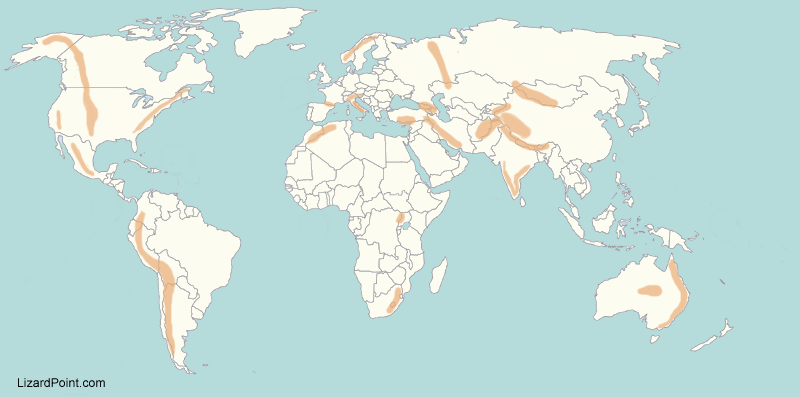This quiz contains a selection of mountain ranges from around the world. These are not the "top" longest or highest ranges.
Definitions:
- mountain: A natural elevation of the earth's surface, typically larger and steeper than a hill. Usually given by geographers as above 1000 feet in height (or 304.8 metres).
- mountain range: A line or series of mountains of similar origin.
- topographic prominence: The prominence of a peak is the height of the peak’s summit above the lowest contour line encircling it but containing no higher summit within it.
Facts/trivia:
- The Himalayas
 mountain range is home to nine of the ten highest peaks in the world. Mount Everest,the highest mountain above sea level, with an elevation of 29,029 ft (8,848 m), is found in the Himalayas. The border between China (Tibet Autonomous Region) and Nepal runs across Everest's summit.
mountain range is home to nine of the ten highest peaks in the world. Mount Everest,the highest mountain above sea level, with an elevation of 29,029 ft (8,848 m), is found in the Himalayas. The border between China (Tibet Autonomous Region) and Nepal runs across Everest's summit.
- The Karakoram
 mountain range, spanning the borders of India, Pakistan, China and Afghanistan, has the highest concentration of peaks over 8000m in height anywhere on earth. K2, the second highest peak in the world, is found in the Karakorams, with a height of 28,251 ft (8,611 m ), located on the border of Pakistan and China.
mountain range, spanning the borders of India, Pakistan, China and Afghanistan, has the highest concentration of peaks over 8000m in height anywhere on earth. K2, the second highest peak in the world, is found in the Karakorams, with a height of 28,251 ft (8,611 m ), located on the border of Pakistan and China.
- The highest mountain in the Americas is Aconcagua, located in the Andes
 mountain range in Argentina. Its height is 22,837.3 ft (6,960.8 m).
mountain range in Argentina. Its height is 22,837.3 ft (6,960.8 m).
- The highest mountain peak in North America is Denali (formerly called Mount McKinley), located in Alaska. Its summit elevation is 20,310 feet (6,190 m) above sea level. It is part of the Alaska Range in the southern part of Alaska.
- The highest mountain in Canada (located in the Yukon) is Mount Logan. It is the second highest mountain in North America.
- The highest mountain in the Alps
 is Mont Blanc, or Monte Bianco (Italian), meaning “White Mountain”. It rises 15,782 ft (4,810.45 m) above sea level.
is Mont Blanc, or Monte Bianco (Italian), meaning “White Mountain”. It rises 15,782 ft (4,810.45 m) above sea level.
- Kilimanjaro, located in Tanzania, is the highest mountain in Africa, at 19,341 feet (5,895 m) above sea level. It is a dormant volcanic mountain with 3 volcanic cones.
- In the United States, the Brooks Range, in northern Alaska, are considered an extension of the Rocky Mountains
 , whereas in Canada they are considered to be separate from the Rockies.
, whereas in Canada they are considered to be separate from the Rockies.
External links:

indicates that the link will open in a new window or tab.

indicates that the link will show the location on the map.
